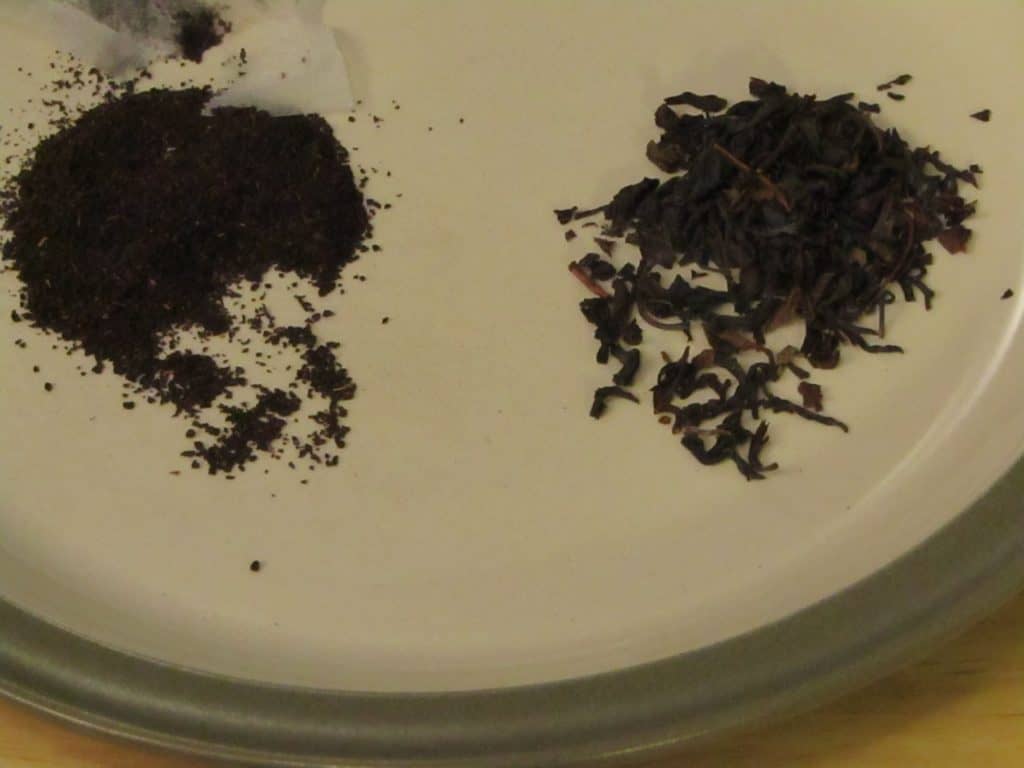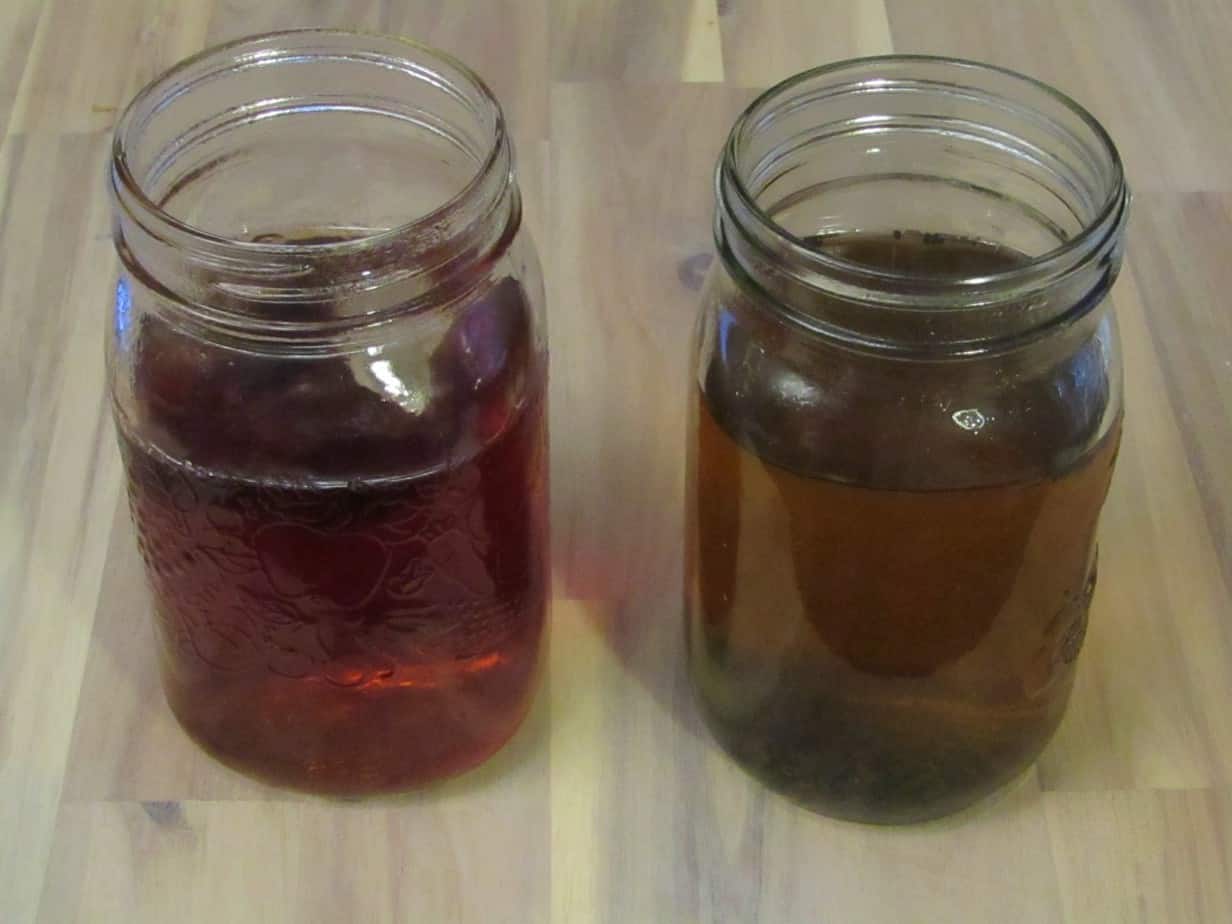This post contains affiliate links.
Kombucha has been made at home all over the world with many different variations from the type of tea to the method of sweetener and yes how long to steep the tea prior to making the kombucha. Most of this stems from personal taste as well as beliefs about the health benefits of different steeping times.
Tea will release its flavor compounds when steeped for 2-5 minutes but to benefit from the tannins, steeping time varies between bagged and whole leaf tea. The high surface area of bagged tea releases its tannins after five minutes whereas loose tea can take up to an hour.
There is a big difference between bagged and loose leaf tea even when it comes to making kombucha. The flavor differences between bagged tea and loose leaf tea is considerable. Since the first aromatic compounds found in all types of tea lose their flavor quickly during fermentation the important compounds are those which are less volatile. It is these compounds which make up the complex flavors found in kombucha.

There are three main compound families found in tea leaves which are released when they are added to hot water: volatile aromatic compounds, caffeine and tannins. Each takes different amounts of time to be released into the hot water and has different effects. These three make up a component of the flavor of kombucha. For a better understanding of where the flavor of kombucha comes from and how you can alter it to suit your needs read this article here.
Or if you want an easy going method for making kombucha without a lot of strict measurements and instructions (after all it really isn’t that hard!) follow this link for my recipe and method.
Steeping time for bagged tea for making kombucha
Bagged tea is often made from finings from the manufacturing process. The fininges are the broken bits of leaves, stems and discolored leaves which do not make the grade for loose leaf tea. This produces inferior flavor from most loose leaf tea and shortens the brewing time due to the large surface area exposed to the hot water.
Steeping time for kombucha made from bagged tea ranges from 2 – 5 minutes depending on whether you are interested simply in the flavor or the health benefits from the tannins. The shorter the steeping time the fewer tannins in the kombucha, lowering its antioxidant properties.
Once you get past five minutes the compounds found in the leaves and water will have reached equilibrium (the concentration of each compound will be the same inside the leaf as outside in the water). This means that after five minutes there will be no perceptible change in the flavor of the tea due to the less volatile components like caffeine and tannins. The aromatic components react quickly with the oxygen in the water and degrade quickly.
Aromatic compounds
The aromatic compounds found in tea leaves are more volatile and are the first to be released into the water. This is why the smell of a freshly poured pot of tea is so great. The compounds are easily released into the air with the steam which comes off the water providing us with this effect.
Being the most volatile, they are the most short-lived flavor elements of tea. During the long fermentation time of kombucha these compounds are mostly lost due to oxygenation.
Caffeine
Caffeine is the next compound to be released into the water. In bagged tea which are mostly small broken particles of tea leaves and stems which do not make the grade for loose leaf tea the surface area of the contact with the water is high. This leads to faster and more caffeine being released into the water. Bagged tea takes 1-2 minutes to reach equilibrium (where there is as much caffeine in the water as in the leaves) at which point the level of caffeine in the tea remains constant.
Tannins
Tannins take the longest to reach equilibrium. They are what adds most of the color to tea. They can be quite bitter and astringent giving the tea a puckering effect when your tea is steeped longer. It is the tannins in the tea which give tea its healthy reputation. Tannins are known for a variety of health benefits which is, presumably, one of the reasons why people drink kombucha.
Just like caffeine tannins in bagged tea are released quickly into the water due to the high surface area contact with the hot water. The tannins will reach equilibrium after five minutes of steeping, providing the most benefit of tannins in your kombucha. After five minutes the level will not increase.
It is important to note that not all types of tea contain the same amount of tannins. Teas which are highly oxidized like black tea and oolong tea contain more tannins than either green or white. This is because during the processing stages of black and oolong tea they are exposed to both heat and oxygen which oxygenates the leaves.
Steeping time
If you are more interested in the flavor components of kombucha then the health benefits then steep your bagged tea for no longer than two minutes. This will give the aromatic compounds and the caffeine enough time to go into solution into the water.
If you are interested in the tannins found in the tea, steeping time of five minutes is necessary to extract the most benefits. After five minutes all the compounds in the tea will have reached equilibrium and some of the aromatic compounds will have dissipated into the air or will have been oxidized. Steeping for a longer period will not affect the levels of caffeine or tannins.
Steeping time for loose leaf tea for making kombucha
Steeping time for kombucha made from loose leaf tea ranges from 2-60 minutes depending on whether you are interested simply in the flavor or the health benefits from the tannins. Tannins in loose leaf tea may take up to 60 minutes to reach equilibrium as the leaf has a small surface area.
Aromatic compounds
The aromatic compounds in loose leaf tea reach equilibrium in 2-3 minutes depending on the type of tea, water temperature and water hardness. Just like bagged tea the aromatic compounds are very volatile and do not last long in the tea. Rather they either escape with the steam or they are oxidized and mellow into the other flavors found in the tea leaves.
This means that the steeping time for kombucha which captures the flavors of a fresh cup of tea is non-existent. Kombucha is fermented for a minimum of 5 days in most cases and up to 60 days. Since after one day the aromatic compounds are dissipated into the air or have oxidized they will not be discernible in the final kombucha.
Caffeine
Caffeine in unbroken tea leaves is slower to be released into the water than the small particles which make up most tea bags. It can take 2-5 minutes for the caffeine to reach equilibrium depending on the water temperature and the type of tea (black, green, oolong, white).
Tannins
The slowest of all compounds found in tea leaves to reach equilibrium. It can take up to 60 minutes for this to happen. Which means that as the tea steeps in hot water the tea will become darker and more bitter as more of the tannins enter the water.
This means that the amount of tannins in the tea for your kombucha can be regulated and fine tuned to provide the best taste and health effects for your tastes. Once the tea has steeped past 5 minutes no more caffeine or flavor compounds will be present but the tannins will continue to slowly increase.
Steeping time
Loose leaf tea can produce the best cup of tea over bagged tea bar none. It can be made just like you like it steeped just the right amount of time to get the flavor and aroma you want in a hot cup of tea. When it comes to kombucha the steeping time does not just vary depending on the flavor you are after but also the health benefits, flavor pairing during second fermentation and how you sweeten it.
Tea lovers have the most control over the components found in the loose leaf tea. This is due to the slower rate of osmosis from the whole leaves. Since the surface area of the whole leaves is drastically smaller than that of bagged tea the tannins take much longer to fully reach equilibrium (where the same concentration is in the water as in the leaves).
The effect of heat on steeping time for making kombucha
Heat greatly affects the speed at which the various components of the tea leaves leach out into the water used for steeping. The hotter the water the faster the tea will reach equilibrium but the components found in the tea are also affected by the type of tea used. Black tea and green tea although they come from the same plant the components produced by processing are very different.
This is why the steeping temperatures of tea vary depending on the type of tea. Black tea has less bitter astringent components in the leaves because during the processing process the leaves are fermented which breaks down some of these compounds. Green tea is not fermented and retains most of the bitter and astringent compounds.
The result is that black tea will produce a mellower cup of tea than green tea made with the same temperature of water and as a result for tea drinkers green tea is usually made with cooler water so the flavor does not get too bitter.
When making tea the temperature of the water should be matched to the type of tea, length of steeping time and personal taste. All tea comes from the same plant; the difference is the method they are harvested, processed, and stored. It is these factors which produce the variation in flavor and health benefits.
Kombucha, on the other hand, benefits from the bitter astringent compounds found in the tea. It is these compounds which provide some of the health benefits in the finished drink as well as providing a bolder flavor which will mellow during fermentation.


